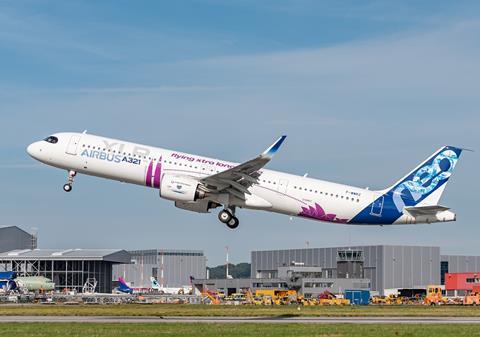Airbus is seeking US regulatory approval to fit mini-suites to the A321XLR, on behalf of a US operator looking to configure the twinjet in a three-class layout.
The airframer formally applied to the US FAA for the clearance on 17 January.
It states that the US carrier wants to install a 155-seat configuration including 20 business, 12 premium-economy and 123 economy seats. The business-class cabin, it adds, will feature mini-suite seats positioned at a 49° angle with respect to the aircraft’s longitudinal axis.
While Airbus has not identified the carrier involved, American Airlines has previously revealed plans for 20 mini-suites, featuring sliding doors, in a herringbone formation on its A321XLRs.

Airbus tells the FAA that complete closure of each single mini-suite would be achieved by a passenger-controlled sliding door, but such installations are not covered by US regulations.
These regulations prevent the installation of doors which separate passenger cabins or present a barrier between passenger seats and emergency exits.
Airbus has requested regulatory exemption from the FAA in order to proceed with the mini-suite installations.
“It is arguable whether the sliding [door] installed on the mini-suites really constitutes [a] ‘door’ in the sense of the rule,” the airframer states.
But it points out that design precautions on the A321XLR will provide an “acceptable level of safety” and eliminate the risk to passengers.

Airbus notes that mini-suites are already fitted to a number of its aircraft models in Europe, while similar mini-suites feature on the Boeing 737 Max.
It has listed several features of the proposed mini-suites to back up its case that they do not present a hazard to passengers, and Airbus also puts forward an economic case for their installation.
“Operators want to provide the traveling public with a very high level of comfort and the possibility to install mini-suites in their aircraft is achieving that goal,” it says. “The ability to install and certify mini-suites in the business class improves the operator’s marketability, and leads to an increase in their sales.”

























